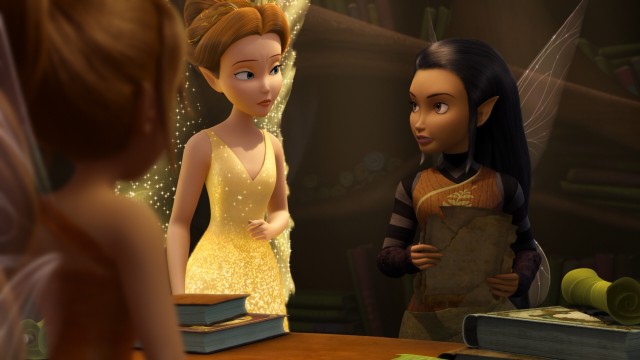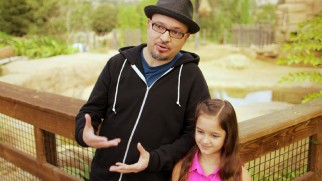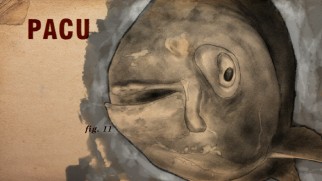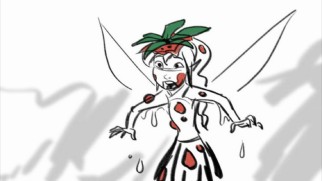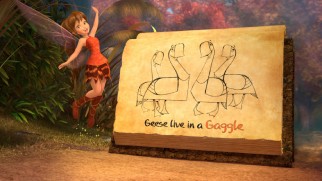Tinker Bell ...the Lost Treasure ...the Great Fairy Rescue Secret of the Wings The Pirate Fairy ...Legend of the NeverBeast
Tinker Bell and the Legend of the NeverBeast: Blu-ray + DVD + Digital HD Review
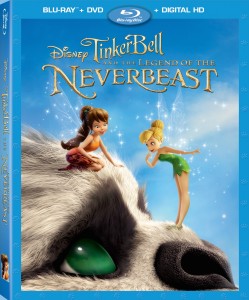 |
Tinker Bell and the Legend of the NeverBeast
Movie, Blu-ray & DVD Details Director: Steve Loter / Writers: Tom Rogers (story & screenplay); Steve Loter (story); Robert Schooley, Mark McCorkle, Kate Kondell (screenplay) Voice Cast: Ginnifer Goodwin (Fawn), Mae Whitman (Tinker Bell), Rosario Dawson (Nyx), Lucy Liu (Silvermist), Raven-Symonι (Iridessa), Megan Hilty (Rosetta), Pamela Adlon (Vidia), Danai Gurira (Fury), Chloe Bennet (Chase), Thomas Lennon (Scribble), Jeff Corwin (Buck), Olivia Holt (Morgan), Grey Griffin (Narrator), Kari Wahlgren (Robin), Anjelica Huston (Queen Clarion) Songs: KT Tunstall - "Float", "Strange Sight", "Strange Sight (reprise)"; Bleu and KT Tunstall - "1000 Years" Running Time: 76 Minutes / Rating: G 1.78:1 Widescreen (DVD Anamorphic) Blu-ray: 7.1 DTS-HD MA (English), Dolby Digital 5.1 (French, Spanish) DVD: Dolby Digital 5.1 (English, French, Spanish) Subtitles: English for Hearing Impaired, English, French, Spanish; DVD Closed Captioned; Extras Subtitled Release Date: October 23, 2012 / Suggested Retail Price: $36.99 Two single-sided discs (1 BD-50 and 1 DVD-9) Blue Keepcase with Side Snap in Embossed, Holographic Cardboard Slipcover Also available as standalone DVD ($29.99 SRP) and Amazon Instant Video |
Buy Tinker Bell and the Legend of the NeverBeast from Amazon.com: Blu-ray + DVD + Digital HD DVD Instant Video
Unless something changes, Tinker Bell and the Legend of the NeverBeast represents the end of an era. It is, for now, the last entry to the Disney Fairies series of computer-animated movies that began in the fall of 2008 with Tinker Bell. For us adults, This direct-to-video series isn't ending because the audience grew up or because Disney is losing money on the latest installments. Actually, it's unclear why the series is ending; an insider report cited declining DVD and merchandise sales, but a seventh film was officially scrapped due to "story problems."
Tolerated by critics, few of whom mustered the vitriol that Disney's earliest direct-to-video efforts inspired, the movies seemed to be well-received by the public as well. Not only did the kids they were primarily aimed at stay satisfied, but some slightly older viewers showed their appreciation as well. For all the horrors the premise first inspired -- Tinker Bell talking! *gasp* -- the series found enough distance from Peter Pan to never feel like sacrilege. This wasn't some untimely sequel predicated on a twist; it was its own property wielding its own mostly original characters and mythology. Sure, it was brand-driven filmmaking, devised as much to sell merchandise as to tell stories. But DisneyToon Studios and the sequel-seasoned animation veterans it entrusted to write and tell these stories did take the task seriously and did enough to avoid comparisons to past misfires and the most obvious competition, those dreadful-looking CGI Barbie movies that just keep coming at least twice a year.
Originally conceived as four movies set around the four seasons, the Disney Fairies line ended up with six feature films, one half-hour television special, and a six-minute short. NeverBeast is absolutely not presented as a finale. It brings no closure to the series and doesn't seem to clearly follow or recall any of its five predecessors (of which I've only seen the first four). For that matter, despite the title, Tinker Bell has a minor role of little significance to the story. Mae Whitman, her voice in every one of these productions, even takes second billing in the end credits.
First billing and protagonist duties belong to Fawn ("Once Upon a Time"'s Ginnifer Goodwin, inheriting the role from Angela Bartys and America Ferrara twice before her). At the start of the movie, the orange-clad animal fairy with light brown hair confesses she has secretly been raising a baby hawk she has named Hannah. As hawks are known to eat fairies, Naming him Gruff, Fawn keeps her new friendship a secret, but she is in disbelief when adversarial scout fairy Nyx (an apparently new character voiced by Rosario Dawson) reveals that legends claim a beast looking just like Gruff arrives shortly after a green comet lands in Pixie Hollow (which it did). According to this legend, the creature has the power to destroy Pixie Hollow using four rock towers, which Gruff has been seen constructing. Fawn cannot believe that Gruff could harm her kind, but after he grows horns and wings, she starts subscribing to the legend and fearing for her home.
Not only is NeverBeast not a swan song, it isn't even attempting to move us from one point to another. In truth, all of these movies have offered standalone narratives, which demand nothing of viewers coming in and do little to leave a mark on them as they go. NeverBeast is brisk, pretty, and forgettable. Someone who cares deeply about this series' universe and its inhabitants might be taken aback to find an entire film devoted to Fawn and this new nonverbal animal. On the other hand, there's no mistaking this for previous outings.
Steve Loter, a TV veteran whose credits include "Kim Possible", "Buzz Lightyear of Star Command", and "The Penguins of Madagascar", is the latest to assume directing duties. The rotating chairs of key creative personnel may account for the series' inconsistency (characters have a tendency to come and go), but the results are once again generally pleasing, if not particularly remarkable or challenging. Judging from the names that feature in the very long end credits scroll, this movie was animated in India. It consistently looks good, impressing most with some nighttime electricity effects. There is even an effort by Loter, who shares story credit with Tom Rogers (who also shares screenplay credit with three others), to pack a little emotion into the proceedings, aided by some original songs by KT Tunstall and Bleu.
Legend of the NeverBeast is now available on DVD, Disney Movies Anywhere, and in the Blu-ray + DVD + Digital HD combo pack reviewed here.
VIDEO and AUDIO
One barely even needs to mention that a brand new digitally animated Disney film looks stupendous on Blu-ray, but NeverBeast does, meeting your tall expectations for such a new production. As I mentioned above, the visuals are quite nice and not just by the modest standards of direct-to-video CGI, which has come a long way (at least outside the Barbie series).
Sound is offered in 7.1 DTS-HD master audio, the most expansive mix today's theatrical fare gets. It makes the most of that format, providing a highly dynamic and effective presentation that's full of directional effects, nicely distributed music, and crystal clear dialogue. A person could not ask for more of this movie from the Blu-ray format.
BONUS FEATURES, MENUS, PACKAGING and DESIGN
"My Dad's Movie: The True Story of the NeverBeast" (5:14) follows director Steve Loter and his daughter Calista to the Santa Barbara Zoo, where they discuss and observe animals and their role in the film.
"Jeff Corwin's Guide to Real-World NeverBeasts" (3:30) lets the animal personality vocally teach us over stills and nature footage about some curious-looking creatures that really do exist.
A deleted scenes section runs 11 minutes and 7 seconds long. It consists of four cut bits presented in story reel form which are each introduced by director Steve Loter, who explains and defends their deletions.
"Tink'n About Animals" (1:51) is an animated short in which Fawn teaches her fellow fairies in song the names of animal groups. It's a creative and informative piece.
Finally, "Gruff Love" (1:32) is a trailer for the movie, The combo pack's DVD, the same one sold on its own, only includes "5 Essential Ingredients to Getting Gruff", "Tink'n About Animals", and "Gruff Love" of the bonus features.
The main menu sees fairies, chicks, and other animals walking across a branch in sassy and spirited fashion while score plays. The Blu-ray remembers where you left off in the movie if you didn't finish it, but doesn't make resuming any quicker or easier than that.
The discs open with a Disney Movies Anywhere promo, followed by trailers for Inside Out and Aladdin: Diamond Edition. The Sneak Peeks listing plays ads for Disney Movie Rewards, Disney Parks, and "Miles from Tomorrowland" before repeating the disc-openers.
Inserts supplying your digital copy information and promoting the Disney Movie Club join the two plainly-labeled discs in a side-snapped keepcase that is topped by an embossed, holographic, glittery slipcover.
CLOSING THOUGHTS
Legend of the NeverBeast ends the Disney Fairies series with more of a whimper than a bang, but these movies have always been a little better than they have to be and this final installment is no exception. A departure from its predecessors, this adventure nonetheless looks nice, holds your attention, and even delivers some emotional payoff.
Joined by some surprisingly solid bonus features, the movie is comparable enough to past episodes to refer you to them in terms of recommending it or not. If you've enjoyed the previous movies enough to want to own them, then you might as well complete the collection. At the same time, it's perfectly understandable if you consider these one-time viewings, especially if you don't have a fairy-crazy girl in your house.
Buy Tinker Bell and the Legend of the NeverBeast from Amazon.com:
|
Related Reviews:
DVDizzy.com | DVD and Blu-ray Reviews | New and Upcoming DVD & Blu-ray Schedule | Upcoming Cover Art | Search This Site
DVDizzy.com Top Stories:
New: Big Hero 6 The Flintstones and WWE: Stone Age Smackdown 101 Dalmatians Gladiators of Rome
Tinker Bell Tinker Bell and the Lost Treasure Tinker Bell and the Great Fairy Rescue Secret of the Wings
Peter Pan Return to Never Land | DisneyToon Studios: Planes Planes: Fire & Rescue
Ginnifer Goodwin: Once Upon a Time: The Complete First Season Ramona and Beezus
Text copyright 2015 DVDizzy.com. Images copyright 2015 Disney, DisneyToon Studios, and Walt Disney Studios Home Entertainment.
Unauthorized reproduction prohibited.


